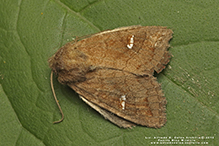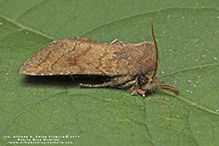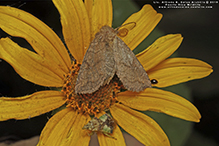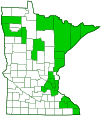Signate quaker
(Tricholita signata)
Conservation • Description • Habitat • Ecology • Distribution • Taxonomy
| Hodges # | 10627 |
||
Conservation Status |
|||
| IUCN Red List | not listed |
||
| NatureServe | NNR - Unranked SNR - Unranked |
||
| Minnesota | not listed |
||
Description
Signate quaker is a late-season, small to medium-sized, owlet moth. It occurs in the United States east of the Great Plains and in adjacent Canadian provinces. It is common in Minnesota. Adults are found from July to September in woodlands, old fields, and sometimes in gardens. Larvae are found on low, early emerging plants, including dandelion and plantain.
Adults are ⅝″ to 11⁄16″ (15 to 18 mm) in length and have a wingspan of 1⅛″ to 1½″ (28 to 38 mm).
The forewings are broadly rounded at the outer margin. They are brown to orangish-brown and are crossed by 3 or 4 dark lines. From the wing base to the tip, these are the antemedial (AM) line, median line, postmedial (PM) line, and subterminal (ST) line. The AM and PM lines are thin and well defined. The ST line is broader with fuzzy edges. It is wavy and does not reach the outer (costal) margin. The median line is actually a band, broad and with blurry, poorly defined edges. It is angled. A small round spot (orbicular spot) in the upper median area is orange or brown with a dark border. A kidney-shaped spot (reniform spot) in the lower median area is brown or orange with a broad, broken, white border. The border is usually almost complete just on the lower half. Sometimes it is reduced to just a few scattered white specks. The top of the reniform spot touches the median band. The wing veins are peppered with tiny white scales.
The hindwings are brownish gray with dark veins. They are not crossed by dark lines.
The head and thorax are the same color as the forewings. On the upper side of the thorax there is a tuft of hairs that is inconspicuously divided into a small tuft in front and a large one in the rear. The antennae on the male are finely branched, feather-like, on one side (pectinate). On the female they are slender and thread-like.
The caterpillar is pale brown, about 1 9⁄16″ (40 mm) long and ¼″ (6 mm) wide. There is a pale line down the middle (middorsal line) with a broad dark margin. The breathing pores (spiracles) are dark brown. The underside is pale and flecked with white. The head is brown with numerous dark “freckles”.
Size
Total length: ⅝″ to 11⁄16″ (15 to 18 mm)
Wingspan: 1⅛″ to 1½″ (28 to 38 mm)
Similar Species
Habitat
Woodlands, old fields, and gardens
Ecology
Season
One generation per year: July to September
Behavior
Adults are active at night and will come to lights.
Life Cycle
Larva Food/Hosts
Low plants, including dandelion and plantain
Adult Food
Distribution |
||
|
Sources 6, 7, 21, 22, 24, 27, 29, 30, 71, 75, 82, 83. Biodiversity occurrence data published by: Minnesota Biodiversity Atlas (accessed through the Minnesota Biodiversity Atlas Portal, bellatlas.umn.edu, 9/27/2025). |
|
| 9/27/2025 | ||
Occurrence |
||
|
||
Taxonomy
Order
Lepidoptera (Butterflies and Moths)
Superfamily
Noctuoidea (Owlet Moths and Allies)
Family
Noctuidae (cutworm moths and allies)
Subfamily
Noctuinae (cutworms and dart moths)
Tribe
Eriopygini (small arches and summer quakers)
Genus
Tricholita
Subordinate Taxa
Synonyms
Tricholita igna
Tricholita semiaperta
Common Names
signate quaker
Glossary
Antemedial (AM) line
A thin line separating the basal area and the median area of the forewing of Lepidoptera.
Orbicular spot
A circular spot or outline in the upper median area near the antemedial line on the forewing of many moths.
Postmedial (PM) line
A thin line separating the median area and the postmedial area of the forewing of Lepidoptera.
Reniform spot
A kidney-shaped spot or outline in the lower median area near the PM line on the forewing of many moths.
Spiracle
A small opening on the surface of an insect or arachnid through which it breathes.
Visitor Photos
Share your photo of this insect.
This button not working for you?
Simply email us at info@MinnesotaSeasons.com.
Attach one or more photos and, if you like, a caption.
Alfredo Colon |
||
 |
 |
|
 |
||
MinnesotaSeasons.com Photos
|

Slideshows
Signate Quaker - Hodges#10627 (Tricholita signata)
Andree Reno Sanborn

Visitor Videos
Share your video of this insect.
This button not working for you?
Simply email us at info@MinnesotaSeasons.com.
Attach a video, a YouTube link, or a cloud storage link.
Other Videos




